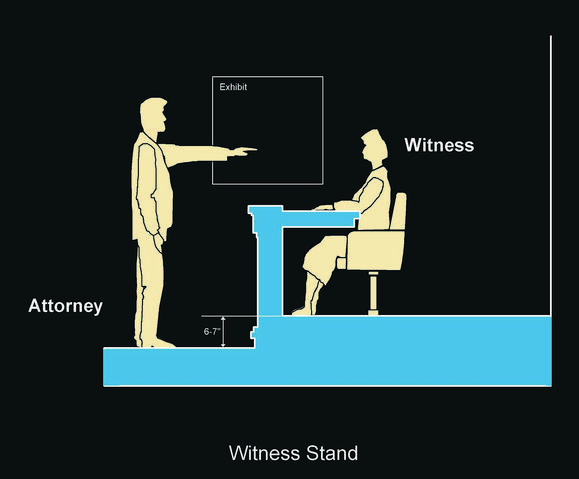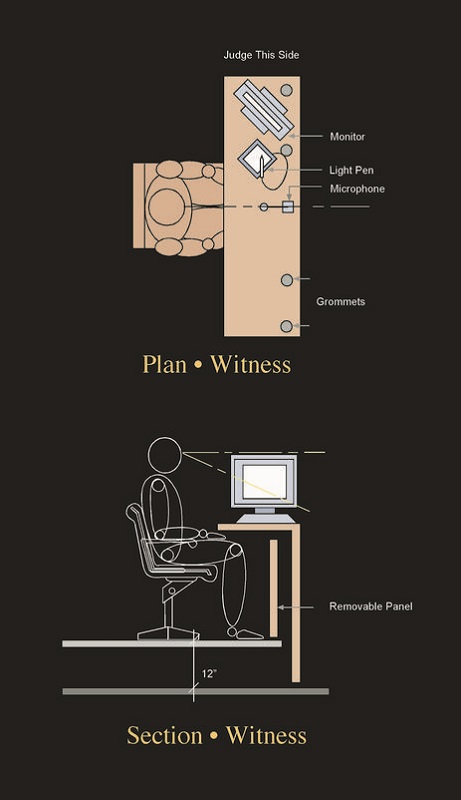The witness, along with the judge, should be a focal point of all courtroom proceedings. All courtroom participants should clearly hear and see all verbal and nonverbal communication from the witness.
 |

The witness stand should be compatible with the style and finishes of the judge's bench and other courtroom furniture.
The witness stand may be elevated on one or two risers from the floor, but should remain lower than the judge. The witness should be clearly visible to the judge, jury, court reporter, and attorneys. If the witness stand is not constructed as part of the bench, it may be preferable that the witness stand be a movable, modular unit, thus allowing it to be rotated to an appropriate angle.
The front width of the witness stand should be at least five feet wide and approximately five feet deep to allow for ease of entry and exit. Because witnesses must frequently receive, examine, and return exhibits, a desk area approximately 15 to 18 inches may be provided to the front or side of the stand on which to rest files or evidence. This shelf area also ensures an adequate non-encroachment distance between the witness and attorneys. The bottom of the desk should be approximately 30 inches from the floor to permit ease of entry and exit. Additional adjacent space should be allowed for an interpreter to stand or sit without blocking the view of the witness.
The area around the witness should be well lit so that the judge, jurors, and attorneys can clearly see the expressions of the witness, but the light source should not be so direct as to cast shadows or glare.
The witness stand in all courtrooms should be accessible to persons with a disability. It should accommodate one accessible wheelchair space, located within the defined area of the witness stand. The requirements for this wheelchair space are essentially the same as those required for jury box: the accessible path must coincide with the normal circulation path to the witness stand, a permanent ramp or lift is required if the position is raised above floor level, and a 30" x 48" wheelchair space is required with unobstructed turning space.
The most common arrangement is to place the witness stand between the jury and the judge, and adjacent to the court reporter's station; this provides the proximity necessary for the witness to be seen and heard clearly. Other possible placements are opposite and facing either the judge or the jury box. The witness stand should be no closer than four to five feet from the jury box so that the nearest juror is seven to eight feet away from the seated witness. This will lessen any feelings of intimidation jurors may have due to their proximity to a criminal defendant or an antagonistic witness. The location of the witness stand should not allow the witness to seize objects from the bench, and there should be a physical barrier between the witness and the judge.
The exhibit area for screens, chalkboards, and video monitors should also be close to the witness stand for ease of reference and demonstration. The exhibit area maybe placed between the witness stand and the jury box for ease of viewing by those participants.
A movable witness stand creates greater flexibility in positioning the witness in different types of hearings.
In those instances that require an interpreter, the interpreter should be easily seen and heard by the court reporter, judge, jurors, and attorneys. A temporary chair may be used for the interpreter, and a microphone may be provided as needed.
In most situations, the witness stand will be entered through the litigation area from the spectator-seating area. When not testifying, witnesses in controversial or emotional trials may be isolated, or excluded from the courtroom, in victim/witness rooms adjacent to the courtroom.
The witness chair should be affixed to the floor to ensure control of prisoners who must testify. To protect the judge from actions of a hostile witness, some physical separation should exist between the witness stand and the judge’s bench.
The witness chair should be stationary to prevent witnesses from backing away from the microphone. Chairs with swivel seats should be comfortable and quiet. A modesty panel should be provided.
There should be electrical receptacles and cable connections for installation of a video display monitor to show recorded evidence, taped depositions and other electronically displayed evidence, and for instant review of real-time case transcripts.
A movable microphone should be mounted unobtrusively in the witness stand and be able to receive clearly the testimony of children and soft‑spoken witnesses. The microphone may be connected to an amplifier controlled by the judge or clerk.
